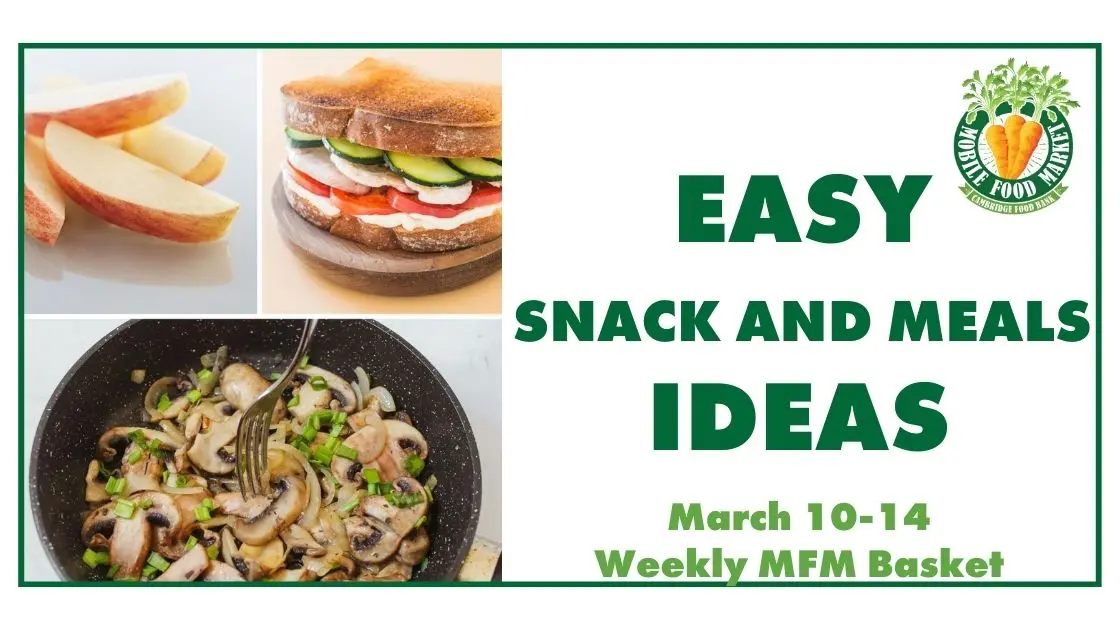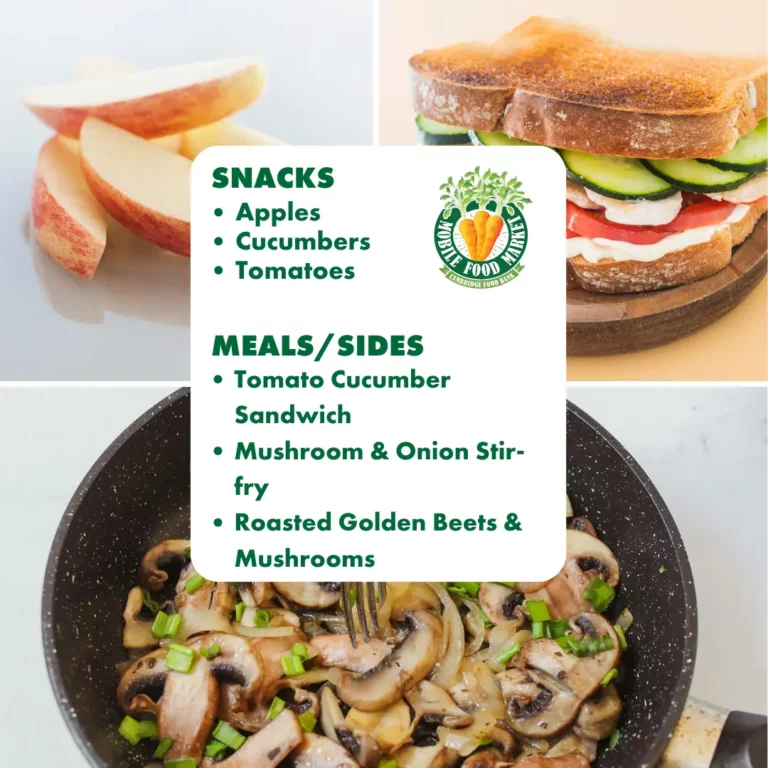Category: Cooking and Food Skills
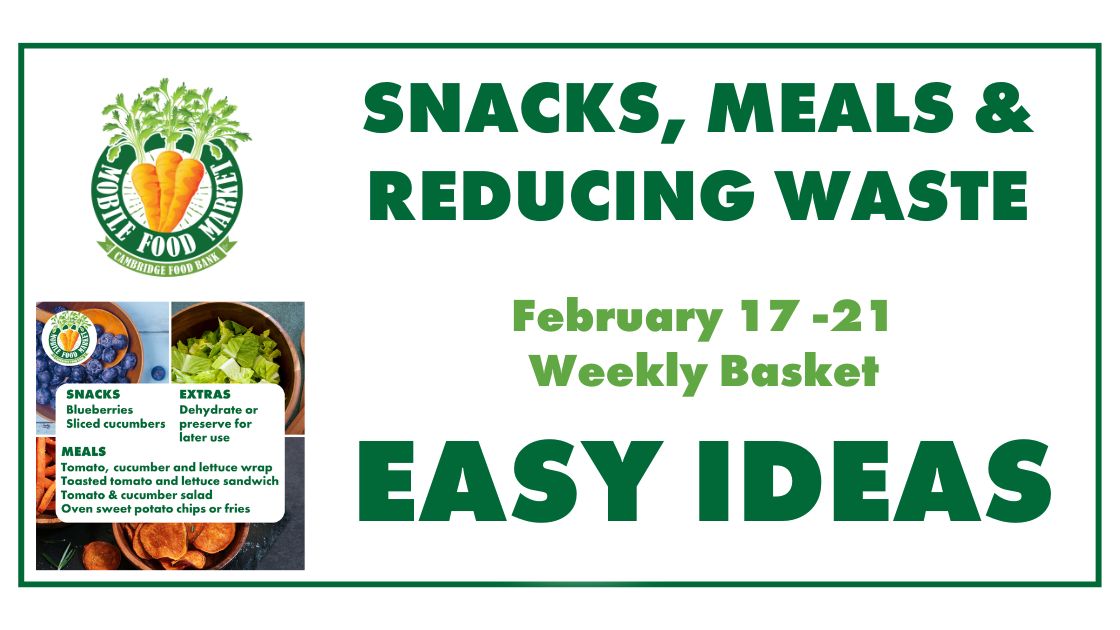
March 3-7 Easy Ideas: Snacks, Meals & reducing waste
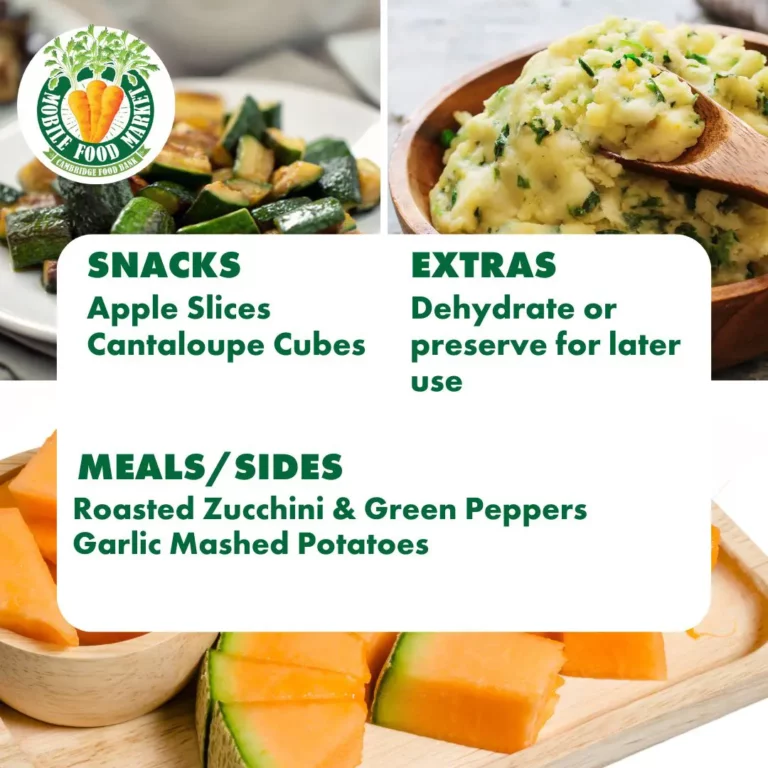
Snack Ideas:
Meal/Side Dish Ideas:
Apple Slices
- Wash apple.
- Slice into thin or thick pieces.
- Serve with peanut butter or enjoy on its own.
Cantaloupe Cubes
- Wash cantaloupe.
- Cut cantaloupe in half and scoop out seeds.
- Slice into cubes and enjoy.
Roasted Zucchini & Green Peppers
- Preheat oven to 400°F.
- Wash zucchini and green peppers
- Slice zucchini and green peppers.
- Toss with oil or melted butter salt, and pepper.
- Roast for 20 minutes, flipping halfway through.
Garlic Mashed Potatoes
- Wash potatoes
- Peel (optional) and chop potatoes.
- Boil until tender, about 15-20 minutes.
- Mash or blend potatoes and add with garlic, butter, and a splash of milk (optional).
Click here and follow Health Canada’s food safety guidelines when following any suggested recipes, preserving, canning, or dehydrating techniques.

February 24-28 Easy Ideas: Snacks, Meals & reducing waste
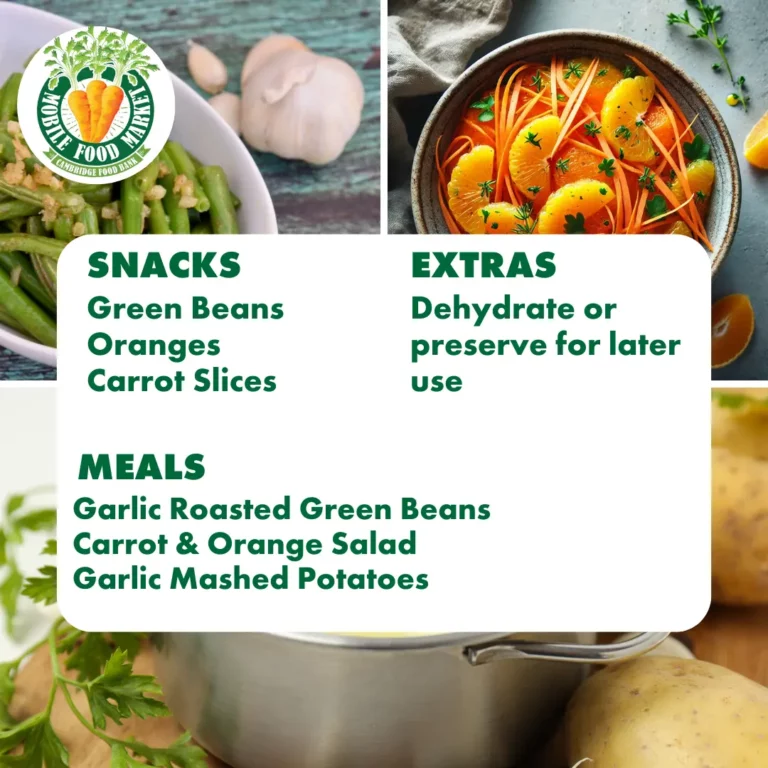
Side Dishes
Side Dishes
Garlic Roasted Green Beans
- Preheat the oven to 400°F.
- Toss green beans with olive oil or butter and minced garlic.
- Season with salt and pepper.
- Roast for 15-20 minutes, shaking halfway through.
Carrot & Orange Salad
- Peel and slice carrots into thin rounds.
- Peel and segment oranges, removing seeds.
- Toss together with a light drizzle of honey or olive oil or any dressing for a refreshing snack.
Tomato & Garlic Bruschetta
- Dice tomatoes and garlic.
- Mix with olive oil, salt, pepper, and fresh basil (optional)
- Serve on toasted bread slices as a quick, fresh snack.
Garlic Mashed Potatoes
- Boil peeled potatoes until tender.
- Mash with garlic, butter or margarine (optional), salt, and pepper.
- Add a splash of milk for creaminess (optional)
Carrot and Green Bean Stir-fry
- Slice carrots into thin matchsticks.
- Heat oil in a pan and stir-fry carrots and green beans.
- Add minced garlic and season with (soy sauce, oil, butter) and pepper.
Tomato & Potato Bake
- Slice potatoes and tomatoes.
- Layer in a baking dish, alternating the slices.
- Drizzle with oil, garlic, salt, and pepper.
- Bake at 375°F for 30-35 minutes.
Click here and follow Health Canada’s food safety guidelines when following any suggested recipes, preserving, canning, or dehydrating techniques.

February 17-21 Easy Ideas: Snacks, Meals & reducing waste
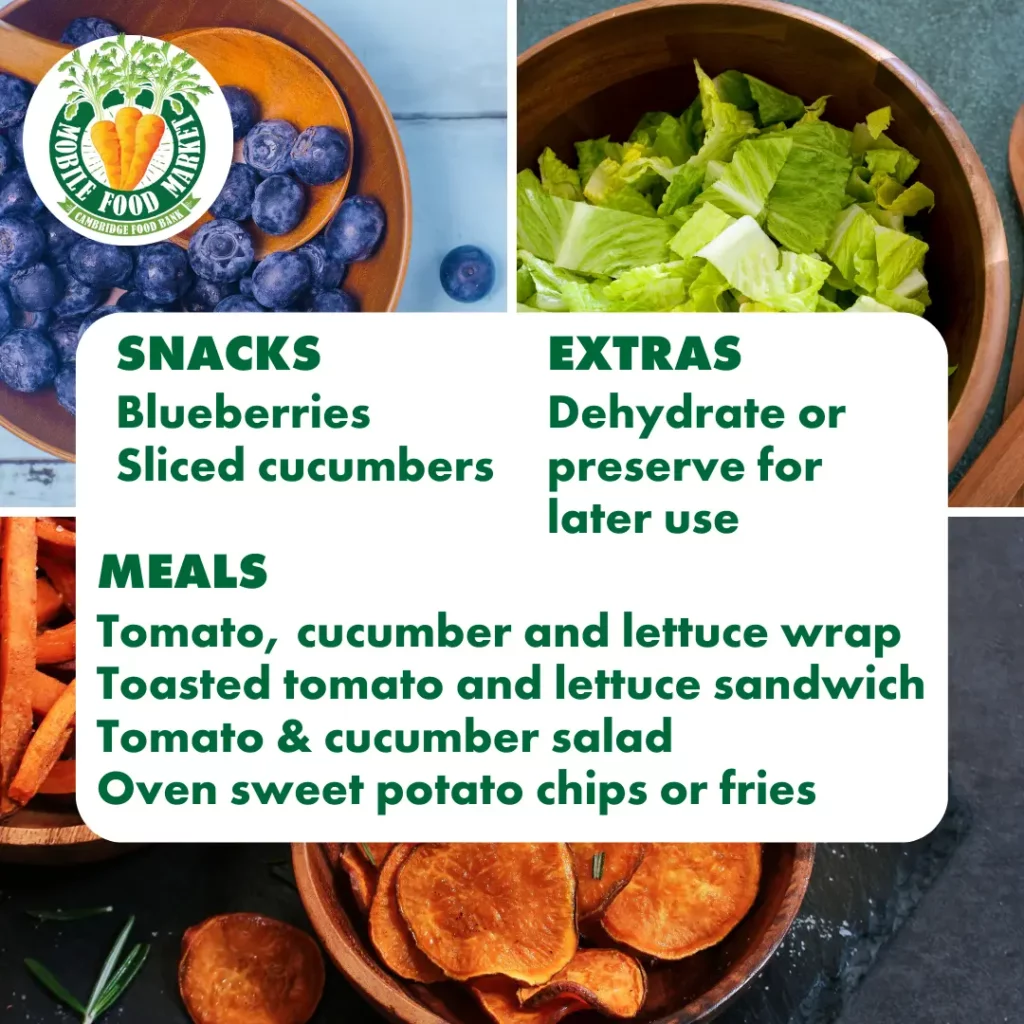
Snacks: Blueberries
Snacks: Sliced Cucumbers
Blueberries are a tasty and healthy snack. Here’s how to prepare them:
- Wash First – Rinse blueberries under cool running water to remove dirt and pesticides. Use a strainer or a bowl of water.
- Eat as They Are – Blueberries are ready to eat—just grab a handful and enjoy!
- or Add to Other Foods – Try blueberries with yogurt, cereal, nuts, granola, a smoothie, or oatmeal.
- Store Correctly – Keep unwashed blueberries in the fridge. Wash only what you need to keep them fresh longer.
Now you’re ready to enjoy a simple, healthy snack!
Cucumbers are a refreshing and healthy snack. Here’s how to prepare them:
- Wash First – Rinse the cucumber under cool running water and gently scrub the skin with your hands or a vegetable brush.
- Slice or Peel (Optional) – You can eat the skin or peel it off with a vegetable peeler if preferred.
- Cut Into Pieces – Slice into rounds, sticks, or cubes, depending on how you like to eat them.
- Pair with Other Foods – Enjoy as is or dip in ranch, hummus, dip, salt & pepper, or add to a salad.
Now you’re ready to enjoy a crisp and tasty snack!
Meals: Sandwich or Wrap
Meal-Side Dish: Oven Roasted Sweet Potato Chips or Fries
How to Make a Toasted Tomato, Lettuce, and Cucumber Sandwich
A fresh and crunchy sandwich that’s easy to make!
- Toast the Bread – Lightly toast two slices of bread until golden brown.
- Wash & Slice – Rinse the tomato, lettuce, and cucumber. Slice the tomato and cucumber into thin rounds.
- Layer the Ingredients – Place lettuce on one slice of bread, then add tomato and cucumber slices.
- Add Extras (Optional) – Spread mayo, mustard, or a favourite dressing for extra flavour or you can add a little salt or pepper.
- Assemble & Enjoy – Place the second slice of bread on top, press gently, and enjoy your sandwich!
How to Make a Tomato, Lettuce, and Cucumber Wrap
A fresh and easy wrap packed with crunch!
- Prepare the Wrap – Use a wrap or flatbread as the base.
- Wash & Chop – Rinse the tomato, lettuce, and cucumber. Chop them into small pieces.
- Add Ingredients – Spread lettuce over the tortilla, then add chopped tomato and cucumber.
- Add Extras (Optional) – Drizzle with dressing or add shredded cheese for more flavour.
- Wrap & Enjoy – Fold in the sides, roll it up tightly, and enjoy your fresh wrap!
How to Make Oven-Roasted Sweet Potato Chips or Fries
A crispy and healthy snack or side dish!
- Preheat the Oven – Set to 400°F (200°C).
- Wash & Slice – Rinse the sweet potato, then slice into thin rounds for chips or strips for fries.
- Season – Toss with a little oil (or use alternatives like melted butter, or broth for a lighter option). Add salt and seasonings like pepper, garlic powder, or paprika or whatever seasonings you might have.
- Bake – Spread in a single layer on a baking sheet. Bake for 20-25 minutes, flipping halfway through.
- Enjoy – Let cool slightly and enjoy crispy sweet potato chips or fries!
Meals-Side Salad:
Extras - Reducing Waste
How to Make a Simple Garden Salad
A fresh and easy salad you can customize!
- Wash & Prep – Rinse the lettuce, tomatoes, and cucumber under cool running water.
- Chop & Slice – Tear the lettuce into bite-sized pieces, chop the tomatoes, and slice the cucumber.
- Mix Together – Add everything to a large bowl.
- Customize (Optional) – Add any other vegetables or proteins you have at home, like carrots, bell peppers, cheese, nuts, chicken, or beans.
- Dress & Enjoy – Toss with your favourite dressing, leave it as is or add salt and pepper and enjoy a fresh, homemade salad!
Purchasing a Mobile Food Market basket can be an adventure—especially when you’re unsure how to use all the items! In addition to our snack and meal ideas, consider ways to save extra food for later.
Can Be Frozen:
- Blueberries
- Tomatoes
- Sweet Potatoes (blanched or mashed)
Can Be Canned:
- Tomatoes (whole, diced, crushed, or as sauce)
- Cucumbers (as pickles)
- Sweet Potatoes (cubed, pressure canned)
Can Be Dehydrated:
- Blueberries
- Romaine Lettuce (for powder)
- Tomatoes (sliced or powdered)
- Cucumbers (as chips)
- Sweet Potatoes (sliced or grated)
Click here to learn more about food preserving.
Click here and follow Health Canada’s food safety guidelines when following any suggested recipes, preserving, canning, or dehydrating techniques.
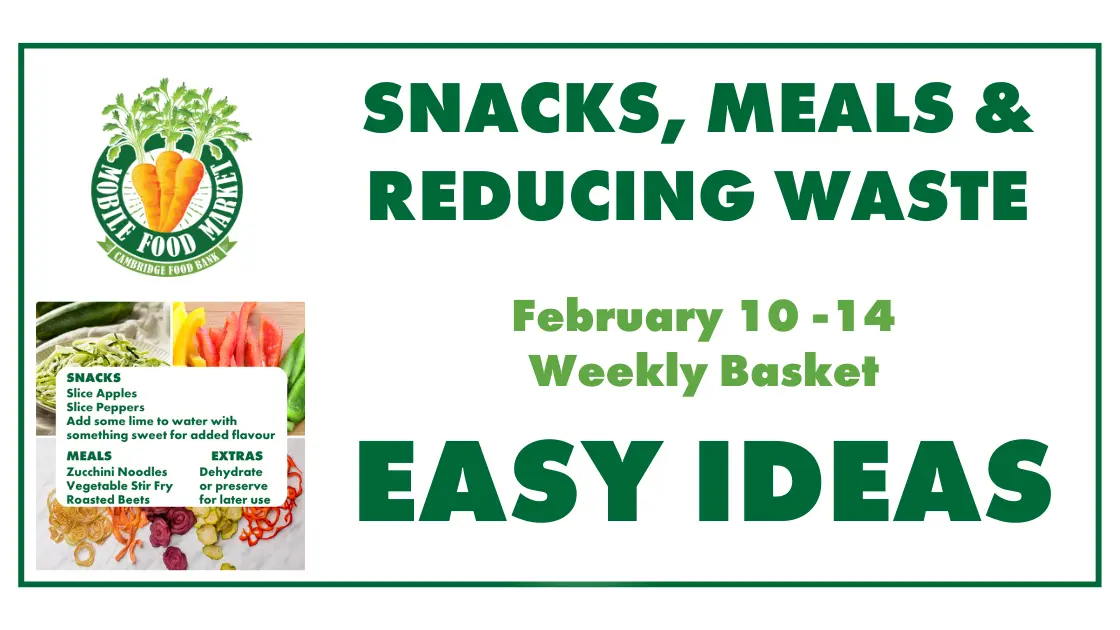
February 10-14 Easy Ideas: Snacks, Meals & reducing waste

Snacks: Apples
Snacks: Peppers
Apples are a sweet, crunchy, and easy-to-prepare fruit. Here’s how to cut them:
- Wash the apple under running water and dry it.
- Place the apple on a cutting board with the stem facing up.
- Cut the apple in half from top to bottom.
- Slice each half in half again to make quarters.
- Remove the core by cutting out the seeds and tough center from each quarter.
- Slice or chop as needed:
- Thin or thick slices for snacking, dipping, or sandwiches.
- Small cubes for adding to salads, yogurt, or oatmeal.
For best freshness, store cut apples in an airtight container and use lemon juice or salt water to prevent browning.
- Salt Water: Soak apple slices in a mixture of ⅓ teaspoon of salt per cup of water for 8–10 minutes, then rinse and dry.
- Lemon Juice: Squeeze a little lemon juice over the slices to slow down browning.
Peppers are a crunchy, colorful, and nutritious addition to snacks and meals. Here’s an easy way to cut them:
- Wash the pepper under running water and dry it with a towel.
- Remove the stem by slicing off the top.
- Cut the pepper in half from top to bottom.
- Scoop out the seeds and white parts using a knife or your hands.
- Slice into strips for dipping or stir-fries, or chop into small pieces for salads, omelets, or pasta dishes.
Store cut peppers in an airtight container in the fridge to keep them fresh!
Meals: Zucchini Noodles
Meals: Vegetable Stir Fry
Zucchini noodles, or “zoodles,” are a great low-carb alternative to pasta. Here’s how to cut and prepare them:
1. Wash and Prep
- Rinse the zucchini under running water and dry it with a towel.
- Trim off both ends with a sharp knife.
2. Choose Your Cutting Method
- Spiralizer (Easiest & Best for Long Noodles): Insert the zucchini into the spiralizer and turn it to create long, curly noodles.
- Julienne Peeler: Drag the peeler down the length of the zucchini to make thin, noodle-like strips.
- Knife Method: Cut the zucchini in half lengthwise, then slice each half into thin strips.
3. Cooking Options
- Raw: Use fresh zoodles in salads or cold pasta dishes.
- Sautéed: Cook in a pan with a little olive oil for 2–3 minutes until just tender.
- Boiled: Drop into boiling water for 1 minute, then drain immediately.
Avoid overcooking to keep the noodles from becoming mushy. Enjoy with your favorite sauce or toppings!
A stir-fry is a quick and flavorful way to enjoy a mix of fresh vegetables. Try this combination using zucchini, beets, onions, bell peppers, and lime!
Ingredients:
- 1 zucchini, sliced thick pieces
- 1 apple, thinly sliced
- 1 beet, peeled and cut into thin pieces
- 1 small onion, sliced into strips
- 1 bell pepper, sliced into strips
- Juice of 1 lime (squeeze juice from lime)
- 1–2 tbsp oil (olive, sesame, or vegetable or you can substitute with any oil or butter)
- 1 tbsp soy sauce or any thin sauce
- ½ tsp garlic (optional)
- ½ tsp ginger or any season or spice you have (optional)
- ½ tsp honey, maple syrup, molasses or a pinch of sugar (optional, for sweetness)
Instructions:
- Heat the oil or butter in a large pan or wok over medium-high heat.
- Add the onions and beets first, since they take longer to cook. Stir-fry for 3–4 minutes.
- Add the zucchini and bell peppers, cooking for another 3 minutes until slightly tender.
- Toss in the apple slices and cook for 1–2 minutes. They should stay slightly crisp.
- Season with garlic, ginger, soy sauce, and lime juice, stirring well to coat everything.
- Taste and adjust flavours, adding a bit of honey, maple syrup or sugar if you like a hint of sweetness.
- Serve hot, on its own or over rice, quinoa, or noodles or eat it as is.
This stir-fry is a great balance of sweet, savory, and tangy flavours—perfect for a quick and healthy meal!
Meals: Roasted Beets Recipe
Extras - Reducing Waste
Roasted beets are naturally sweet, tender, and a great addition to any meal. Here’s an easy way to prepare them, along with some substitute options!
Ingredients:
- 3–4 medium beets
- 1–2 tbsp oil (olive oil, or substitute with melted butter, coconut oil, or vegetable broth for an oil-free option)
- ½ tsp salt
- ¼ tsp black pepper (optional)
- 1 tsp balsamic vinegar or lemon juice (or substitute with apple cider vinegar, lime juice, orange juice, or a little maple syrup for sweetness)
Instructions:
- Preheat oven to 400°F (200°C).
- Wash and peel the beets (or leave the skin on and peel after roasting).
- Cut the beets into wedges or cubes for faster roasting.
- Toss with oil (or substitute) and seasonings in a bowl until evenly coated.
- Spread on a baking sheet in a single layer.
- Roast for 30–40 minutes, stirring halfway through, until tender and slightly caramelized.
- Drizzle with balsamic vinegar, lemon juice, or a substitute before serving for added flavor.
Serving Ideas:
- Enjoy as a side dish, in salads, or on grain bowls.
- Toss with nuts, goat cheese, or fresh herbs for extra flavor.
This flexible recipe makes it easy to enjoy roasted beets with whatever ingredients you have on hand!
Purchasing a Mobile Food Market basket can be an adventure—especially when you’re unsure how to use all the items! In addition to our snack and meal ideas, consider ways to save extra food for later. With food costs rising, preserving what you have helps reduce waste and makes meal prep easier when ingredients are ready to use.
If you have extra apples, zucchini, beets, onions, bell peppers, or limes, try these storage methods:
- Freezing: Chop and freeze in airtight containers. Blanching (quick boiling) helps retain texture for veggies like zucchini and beets.
- Canning: Pickle beets, onions, or zucchini in vinegar, or make applesauce. Process in a hot water bath for safe storage.
- Dehydrating: Slice and dry in a dehydrator or low-temperature oven for long-term storage—great for making chips or powders!
Click here for detailed step-by-step instruction.
Click here and follow Health Canada’s food safety guidelines.

How to Freeze, Preserve or Dehydrate Items from one of our Mobile Food Market Basket
When you have extra produce, preserving it ensures you can enjoy it later. Below are different methods for freezing, preserving in jars, and dehydrating apples, zucchini, beets, onions, bell peppers, and lime.
1. Freezing
Freezing is an easy way to keep produce fresh for months. Most vegetables need to be blanched before freezing to maintain texture and color.
Apples:
- Slice apples and remove seeds.
- To prevent browning, toss in lemon or lime juice.
- Lay slices on a baking sheet in a single layer and freeze for 1–2 hours.
- Transfer to freezer bags or containers, removing as much air as possible.
- Use for: Smoothies, baking, or blend into applesauce.
Zucchini (for cooking or zoodles):
- Wash and cut into slices, cubes, or zoodles.
- Blanch in boiling water for 1–2 minutes, then immediately cool in ice water.
- Drain well and freeze on a baking sheet before transferring to bags.
- Use for: Soups, stir-fries, or blending into sauces.
Beets:
- Wash, peel, and cut into slices or cubes.
- Blanch for 2–3 minutes, then cool in ice water.
- Spread on a baking sheet to freeze before transferring to bags.
- Use for: Roasting, salads, or smoothies.
Onions:
- Peel and chop (diced or sliced).
- Spread in a single layer on a baking sheet and freeze for 1 hour.
- Transfer to freezer bags.
- No blanching needed!
- Use for: Cooking (soups, stir-fries, omelettes).
Bell Peppers:
- Wash, remove seeds, and slice or dice.
- Spread on a baking sheet and freeze for 1 hour.
- Transfer to freezer bags.
- No blanching needed!
- Use for: Stir-fries, omelets, soups.
Lime (Juice & Zest):
- Juice: Squeeze and pour into ice cube trays, then transfer cubes to a bag.
- Zest: Grate the peel and store in a small container or freezer bag.
- Use for: Dressings, marinades, and baking.
2. Preserving in Jars – click here for important safety tips
Canning is great for long-term storage without freezing.
Apples (Apple Sauce or Apple Butter):
- Cook peeled and sliced apples with a little water until soft.
- Mash or blend, then add cinnamon or sugar if desired.
- Pour into sterilized jars and process in a hot water bath for 10 minutes.
- Use for: Spreading on toast, baking, or eating as-is.
Zucchini (Pickles or Relish):
- Slice zucchini into rounds or sticks/spears.
- Pack into sterilized jars with vinegar, garlic, dill, and salt.
- Process in a hot water bath for 10–15 minutes.
- Use for: Sandwiches, salads, or snacking.
Beets (Pickled Beets):
- Boil or roast whole beets until soft, then peel and slice.
- Pack into sterilized jars with a hot brine (vinegar, sugar, salt, and spices).
- Process in a hot water bath for 30 minutes.
- Use for: Salads, side dishes, or sandwiches.
Onions (Pickled Onions):
- Slice onions thinly and pack into sterilized jars.
- Pour hot vinegar brine (vinegar, sugar, salt) over them.
- Store in the fridge for up to 1 month or process in a hot water bath for 10 minutes for longer storage.
- Use for: Burgers, tacos, sandwiches.
Bell Peppers (Roasted and Preserved in Oil/Vinegar):
- Roast peppers, peel the skin, and slice.
- Pack into jars with vinegar or oil and a little salt.
- Store in the fridge or process in a hot water bath for 15 minutes.
- Use for: Sandwiches, pasta, or antipasto platters.
Be sure to follow Health Canada’s guidelines on canning any fruits and vegetables.
3. Dehydrating
Dehydrating removes moisture for long-term storage. You can use a dehydrator or an oven at 135–150°F (57–65°C) with the door slightly open.
Apples (Apple Chips):
- Slice apples thinly and dip in lemon water to prevent browning.
- Arrange on dehydrator trays or a baking sheet.
- Dehydrate at 135°F (57°C) for 6–8 hours until crisp.
- Use for: Snacking, granola, or baking.
Zucchini (Zucchini Chips or Powder):
- Slice into thin rounds or shred for powder.
- Dehydrate at 125°F (52°C) for 6–12 hours.
- Blend dried zucchini into powder for soups or sauces.
- Use for: Snacks, soups, or pasta sauce thickener.
Beets (Beet Chips or Powder):
- Slice thinly and arrange on trays.
- Dehydrate at 135°F (57°C) for 6–10 hours.
- Blend dried beets into a powder for smoothies.
- Use for: Snacking or adding color to food.
Onions (Dried or Powdered):
- Slice onions into thin rings.
- Dehydrate at 125°F (52°C) for 6–10 hours until brittle.
- Blend into onion powder if desired.
- Use for: Cooking, soups, seasonings.
Bell Peppers (Dried Strips or Powder):
- Cut into strips or dice.
- Dehydrate at 125°F (52°C) for 8–12 hours.
- Blend dried peppers into a powder for seasoning.
- Use for: Soups, casseroles, or spice blends.
Lime (Dried Slices or Powder):
- Slice thinly and remove seeds.
- Dehydrate at 125°F (52°C) for 6–8 hours.
- Use whole dried slices for tea or grind into lime powder.
- Use for: Drinks, marinades, seasoning.
After any dehydration process, remove the dehydrated pieces to place in a glass jar. Any pieces that feel like they are still not fully dry, put them back into the dehydrator until dried.
Follow this link to learn more about the dehydrating process.

